JavaScript is disabled for your browser. Some features of this site may not work without it.
Mostrar el registro sencillo del ítem
| dc.coverage.spatial | Lago Caviahue. Neuquén; Patagonia ARG | es_ES |
| dc.creator | Cuevas, Mayra | |
| dc.creator | Issotta, Francisco | |
| dc.creator | Díaz-González, Fernando | |
| dc.creator | Diaz, Mónica | |
| dc.creator | Quatrini, Raquel | |
| dc.creator | Beamud, Guadalupe | |
| dc.creator | Pedrozo, Fernando | |
| dc.creator | Temporett, Pedro | |
| dc.date | 2024 | |
| dc.date.accessioned | 2025-05-26T14:14:45Z | |
| dc.date.available | 2025-05-26T14:14:45Z | |
| dc.identifier.uri | https://rdi.uncoma.edu.ar/handle/uncomaid/18722 | |
| dc.description.abstract | Lake Caviahue (37° 50 ‘S and 71° 06’ W; Patagonia, Argentina) is an extreme case of a glacial, naturally acidic, aquatic environment (pH ~ 3). Knowledge of the bacterial communities in the water column of this lake, is incipient, with a basal quantification of the bacterioplankton abundance distribution in the North and South Basins of Lake Caviahue, and the described the presence of sulfur and iron oxidizing bacteria in the lake sediments. The role that bacterioplankton plays in nutrient utilization and recycling in this environment, especially in the phosphorus cycle, has not been studied. In this work, we explore this aspect in further depth by assessing the diversity of pelagic, littoral and sediment bacteria, using state of the art molecular methods and identifying the differences and commonalties in the composition of the cognate communities. Also, we investigate the interactions between the sediments of Lake Caviahue and the microbial communities present in both sediments, pore water and the water column, to comprehend the ecological relationships driving nutrient structure and fluxes, with a special focus on carbon, nitrogen, and phosphorus. Two major environmental patterns were observed: (a) one distinguishing the surface water samples due to temperature, Fe2+, and electrical conductivity, and (b) another distinguishing winter and summer samples due to the high pH and increasing concentrations of N-NH4 +, DOC and SO4 2−, from autumn and spring samples with high soluble reactive phosphorus (SRP) and iron concentrations. The largest bacterial abundance was found in autumn, alongside higher levels of dissolved phosphorus, iron forms, and increased conductivity. The highest values of bacterial biomass were found in the bottom strata of the lake, which is also where the greatest diversity in microbial communities was found. The experiments using continuous flow column microcosms showed that microbial growth over time, in both the test and control columns, was accompanied by a decrease in the concentration of dissolved nutrients (SRP and N-NH4 +), providing proof that sediment microorganisms are active and contribute significantly to nutrient utilization/mobilization | es_ES |
| dc.format | application/pdf | es_ES |
| dc.format.extent | pp.1-20 | es_ES |
| dc.language | eng | es_ES |
| dc.publisher | Frontiers Media S.A. | es_ES |
| dc.relation.uri | https://doi.org/10.3389/fmicb.2024.1335978 | es_ES |
| dc.rights | Atribución-NoComercial-CompartirIgual 4.0 | es_ES |
| dc.rights.uri | https://creativecommons.org/licenses/by-nc-sa/4.0/ | es_ES |
| dc.source | Frontiers in Microbiology. Volume 15 - 2024 | es_ES |
| dc.subject | Bacteria | es_ES |
| dc.subject | Nutrients | es_ES |
| dc.subject | Microbial communities | es_ES |
| dc.subject | Water–sediment interface | es_ES |
| dc.subject | Acidic lake | es_ES |
| dc.subject | Argentinean Patagonia | es_ES |
| dc.subject.other | Ciencias de la Tierra y Medio Ambiente | es_ES |
| dc.title | Nutrient structure dynamics and microbial communities at the water–sediment interface in an extremely acidic lake in northern Patagonia | es_ES |
| dc.type | Articulo | es |
| dc.type | article | eu |
| dc.type | acceptedVersion | eu |
| dc.description.fil | Fil: Cuevas, Mayra. Universidad Nacional del Comahue. Centro Regional Universitario Bariloche; Argentina. | es_ES |
| dc.description.fil | Fil: Cuevas, Mayra. Consejo Nacional de Investigaciones Científicas y técnicas. Instituto de Investigaciones en Biodiversidad y Medioambiente; Argentina. | es_ES |
| dc.description.fil | Fil: Issotta, Francisco. Centro Científico y Tecnológico de Excelencia Ciencia & Vida. Fundación Ciencia & Vida; Chile. | es_ES |
| dc.description.fil | Fil: Issotta, Francisco. Universidad Católica de Chile. Department of Molecular Genetics and Microbiology. School of Biological Sciences; Chile. | es_ES |
| dc.description.fil | Fil: Díaz-González, Fernando. Centro Científico y Tecnológico de Excelencia Ciencia & Vida. Fundación Ciencia & Vida; Chile. | es_ES |
| dc.description.fil | Fil: Díaz-González, Fernando. Universidad San Sebastián. Facultad de Medicina y Ciencia; Chile. | es_ES |
| dc.description.fil | Fil: Diaz, Mónica. Universidad Nacional del Comahue. Centro Regional Universitario Bariloche; Argentina. | es_ES |
| dc.description.fil | Fil: Diaz, Mónica. Consejo Nacional de Investigaciones Científicas y técnicas. Instituto de Investigaciones en Biodiversidad y Medioambiente; Argentina. | es_ES |
| dc.description.fil | Fil: Quatrini, Raquel. Centro Científico y Tecnológico de Excelencia Ciencia & Vida. Fundación Ciencia & Vida; Chile. | es_ES |
| dc.description.fil | Fil: Quatrini, Raquel. Universidad San Sebastián. Facultad de Medicina y Ciencia; Chile. | es_ES |
| dc.description.fil | Fil: Beamud, Guadalupe. Universidad Nacional del Comahue. Centro Regional Universitario Bariloche; Argentina. | es_ES |
| dc.description.fil | Fil: Beamud, Guadalupe. Consejo Nacional de Investigaciones Científicas y técnicas. Instituto de Investigaciones en Biodiversidad y Medioambiente; Argentina. | es_ES |
| dc.description.fil | Fil: Fernando Pedrozo. Universidad Nacional del Comahue. Centro Regional Universitario Bariloche; Argentina. | es_ES |
| dc.description.fil | Fil: Fernando Pedrozo. Consejo Nacional de Investigaciones Científicas y técnicas. Instituto de Investigaciones en Biodiversidad y Medioambiente; Argentina. | es_ES |
| dc.description.fil | Fil: Temporett, Pedro. Universidad Nacional del Comahue. Centro Regional Universitario Bariloche; Argentina. | es_ES |
| dc.description.fil | Fil: Temporett, Pedro. Consejo Nacional de Investigaciones Científicas y técnicas. Instituto de Investigaciones en Biodiversidad y Medioambiente; Argentina. | es_ES |
| dc.cole | Artículos | es_ES |



